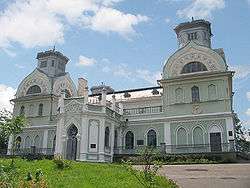Korsun-Shevchenkivskyi
Korsun-Shevchenkivskyi (Ukrainian: Ко́рсунь-Шевче́нківський, pronounced [ˈkɔrsʊnʲ ʃeu̯ˈtʃɛnkiu̯sʲkɪj]; Polish: Korsuń Szewczenkowski; Russian: Корсунь-Шевченковский) is a small city located in Cherkasy Oblast (province) in central Ukraine. The city rests on the banks of the Ros River, and is the administrative center of Korsun-Shevchenkivskyi Raion (district). Population: 18,192 (2017 est.)[1]
Korsun-Shevchenkivskyi Корсунь-Шевченківський | |
|---|---|
 A palace of the family of Lopukhinykh-Demydovykh in Korsun-Shevchenkivskyi. | |
 Flag  Coat of arms | |
 Map of Ukraine with Korsun-Shevchenkivskyi highlighted. | |
 Korsun-Shevchenkivskyi Location of Korsun-Shevchenkivskyi | |
| Coordinates: 49°29′N 31°17′E | |
| Country Oblast Raion | Korsun-Shevchenkivskyi |
| First mentioned | 1032 |
| Area | |
| • Total | 118.65 km2 (45.81 sq mi) |
| Elevation | 94 m (308 ft) |
| Population (2017) | |
| • Total | 18,192 |
| • Density | 163/km2 (420/sq mi) |
| Postal code | 19400 |
| Area code(s) | +380 4735 |
| Sister cities | Gifhorn |
_(1).jpg)

History
A fortress Korsun was founded in 1032 by the Kievan Rus' prince Yaroslav the Wise and served the protection of Kiev from nomads from the southern steppe regions. The name of the city comes from the Greek city of Chersones (translated as Korsun) on the Crimean Peninsula. In 1240, Korsun was destroyed by Batu Khan. In 1584, a military base was established in the city.
In the early modern times the place belonged to the Polish-Lithuanian Commonwealth, during which another fortress was built and the city received the Magdeburg rights. In 1630, Cossack rebels led by Taras Fedorovych attacked the town and destroyed its Polish garrison. The town was razed by Polish forces during the 1637 Cossack rebellion led by Pavlo Pavliuk. In 1648, the Battle of Korsuń during the Khmelnytsky Uprising, took place here. In 1768, during the Koliyivschyna Rebellion, the Polish garrison was destroyed by the forces of Maksym Zalizniak.
In 1793, Korsun was included into the Russian Empire. In 1903, one of the largest paint factories in the whole Russian Empire was built in Korsun. In the period of the Second World War (1941–1945), the Soviet Red Army defeated the German forces in the area surrounding Korsun (for further information, see Korsun Pocket). On February 14, 1944, Korsun was cleared of German forces.
In post-war years, the farm and agricultural economy of Korsun was soon rebuilt. Until 1944, the city was known simply as Korsun, however, it was later renamed in honor of Taras Shevchenko, a famous Ukrainian poet and artist.
Economy
Korsun-Shevchenkivskyi contains a railroad station Korsun, on the railroad line Kyiv-Zvitkovo. Korsun-Shevchenkivskyi also contains many industrial factories, namely some mechanical factories, a construction material factory, an asphalt factory, a winemaking factory, sewing factory, and others.
Architecture
- A park complex belonging to the former palace of the noble Lopukhinykh-Demydovykh family, considered one of the best natural park complexes in the style of Romanticism in Ukraine. The park was constructed in 1782 by the request of the noble Stanisław Poniatowski, the King of Poland and Grand Duke of Lithuania, a writer and artist. In the middle of the 19th century, the park was decorated with many sculptures. In addition, small pedestrian bridges were added. Total area of the park – 97 hectares.
- The palace of the noble Lopukhinykh-Demydovykh family.
- The Korsun-Shevchenkivskyi historical-cultural preserve.
- Museum dedicated to the history of the Korsun-Shevchenkivskyi Battle.
Famous people
- Vasyl Avramenko, actor, dancer, choreographer, balletmaster, director, and film producer
- Anatoli Khorozov, president of the Ice Hockey Federation of Ukraine, hotel businessman
- Kyrylo Stetsenko, composer, conductor, critic, and teacher
International relations
Twin towns – Sister cities
Korsun-Shevchenkivskyi is twinned with:
Gallery
 A branch of the Ros' River near the palace of the Lopukhinykh-Demydovykh family.
A branch of the Ros' River near the palace of the Lopukhinykh-Demydovykh family. Entrance to the premises of the palace of the family of Lopukhinykh- Demydovykh.
Entrance to the premises of the palace of the family of Lopukhinykh- Demydovykh. Korsun-Shevchenkivskyi's city center.
Korsun-Shevchenkivskyi's city center..jpg) Monument to Taras Shevchenko near the entrance to a nature preserve.
Monument to Taras Shevchenko near the entrance to a nature preserve.
See also
- Korsun Pocket – 1944 battle on the Eastern Front of World War II.
- Battle of Korsun – 1648 battle during the Khmelnytsky Uprising.
References
Notes
- "Чисельність наявного населення України (Actual population of Ukraine)" (in Ukrainian). State Statistics Service of Ukraine. Retrieved 26 August 2017.
Sources
- (1972) Історіа міст і сіл Української CCP - Черкаська область (History of Towns and Villages of the Ukrainian SSR - Cherkasy Oblast), Kyiv. (in Ukrainian)
- Korsun-Shevchenkivskyi in the Encyclopedia of Ukraine
External links
| Wikimedia Commons has media related to Korsun-Shevchenkivskyi. |
- korsun.ic.ck.ua - Website of the historical-cultural preserve in the city
- heraldry.com.ua - Coat of arms of Korsun-Shevchenkivskyi (Ukrainian)
- sunsite.berkeley.edu - Soviet topographic map 1:100,000